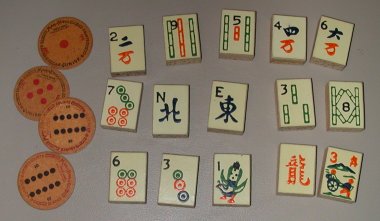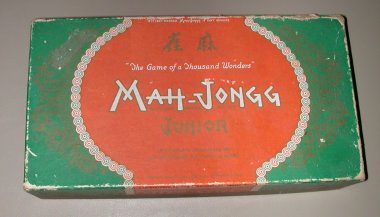
I've
written before about my nigh-cosmic interest in classical table games— board games, card games, throw in tile games and dice games, too. As for tile games, you think chiefly of dominoes; I've also got in my collection a set of Chinese dominoes, which are rather different. But most exotic of all among tile games is the mysterious oriental game of mah jongg. Above are some tiles from one of my mah jongg sets— a wooden set from the early 1920s, when the mah jongg craze hit the United States.

Here's the box for that set: "The Game of a Thousand Wonders: Mah-Jongg 'Junior': A Complete Mah-Jongg Set with Babcock's Red Book of Rules." More: "Manufactured by the Paraffine Companies Inc. for, and Sold Only by, Mah-Jongg Sales Co. of America, San Francisco, New York, Chicago." The included rule book is in its tenth printing, July 1923.

Here are some tiles from another mah jongg set I've got. These tiles are made of bakelite, much more finely detailed than the first set. I'd guess they also date from the 1920s.

These bakelite tiles come, along with bakelite tile racks, in a green faux-alligator carrying case. (My wooden mah jongg set also has racks, of wood, which may or may not have originally belonged as part of the set.)
I first got interested in mah jongg back in my high school years— early 1970s. In those days there was virtually no place you could buy a mah jongg set, outside of an antique shop, which I was too impecunious to afford; though I do recall seeing a new mah jongg set in a department store somewhere— could that have been (local Madison, Wisconsin reference) "Manchester's, East, West, and on the Square"?
Books on mah jongg weren't much easier to come by. One of the few sources in this country back then for items relating to oriental games was the Charles E. Tuttle Company in Rutland, Vermont. I ordered from them the several mah jongg books they had in stock, and read these books cover to cover. Over and over again. Like I say, I took a nigh-cosmic interest in games, the more "far-out" the better. In those days, there simply was no outlet in our culture for interests like this, I was on my own.

The summer I turned 18, I decided to make my own mah jongg set. By hand. Here are some tiles from my set— I based the designs the best I could on pictures in those books. I'd never seen a real mah jongg set with my own eyes at this point— those other two sets, I acquired in my twenties— so the wooden tiles in my handmade set were only about half as thick as they should have been. Still, it was a nice job considering I was flying by dead reckoning, and also considering that I have very little practical talent for "making" things with my hands.

I also produced a box for my homemade mah jongg set. For some reason, I did up the box not in English, not in Chinese or Japanese, but in
my own language, Hermetic. Rough translate of the top of the box: "Mah Jongg Set: Chinese style; The set consists of 144 tiles; Handmade; Includes other necessary game implements for mah jongg, except for tile racks." Like most homemade game sets I produced in those years, this one is marked
Zinir— "For Export." A quote in Hermetic at the top reads, "Mah Jongg tiles are one of the six or eight most noble games of ancient Terra— Venerable Mei-San,
Mei-San's Compendium" (A mythical 40-volume encyclopedia of games from across the galaxy) The manufacturer: "Ivory Star Game Implements, 5ThJ Eclipsist Realm"; which situates my homemade mah jongg set somewhere in the vast galactic "future history" which I drew up and wrote countless stories about in those years.

Well. On the way down to Dubuque
last week, I stopped off at that antique mall and found a set of mah jongg
cards, pictured above. "Man-Chu, the Famous Chinese Game," produced by the United States Playing Card Company, 1923. Includes a booklet,
Foster's Famous Rules for Man-Chu.

Here's the mah jongg deck and the box it came in.
And finally, discounting those booklets that came with the mah jongg sets themselves, here's a more or less complete list of the mah jongg books I've accumulated in my personal library over the years:
- Eleanor Noss Whitney, A Mah Jong Handbook: How to Play, Score, and Win the Modern Game. Rutland, Vermont & Tokyo, Japan: Charles E. Tuttle Company, 1964.
- Marcia Hammer, Learn to Play Mah Jongg. New York: David McKay Company, Incorporated, 1979.
- Shozo Kanai and Margaret Farrell, Mah Jong for Beginners: Based on the Rules and Regulations of the Mah Jong Association of Japan. Rutland, Vermont & Tokyo, Japan: Charles E. Tuttle Company, 1952.
- Kitty Strauser and Lucille Evans, Mah Jong, Anyone?: A Manual of Modern Play. Rutland, Vermont & Tokyo, Japan: Charles E. Tuttle Company, Inc., 1964.
- Edgar S. Winters, Ma Cheuk as Played by the Chinese. New York: E.P. Dutton & Company, 1923.
- Jean Bray, How to Play Mah Jong. New York & London: G.P. Putnam's Sons, 1923.
- L.L. Harr, How to Play Pung Chow: The Game of a Hundred Intelligences. New York & London, Harper & Brothers, Publishers, 1923.
- Ralph J.F. Gerstle, Ma Jong: The Green Book. Third Edition. Chicago: Ma-Jong Club of Chicago, Inc., 1923.
- J.P. Babcock, Babcock's Rules for Mah-Jongg, the Fascinating Chinese Game. Second Edition. Shanghai, China: Mah-Jongg Company of China, 1920.
- Henry M. Snyder, The Ma-Jung Manual. Edited by Robert F. Foster. Boston and New York: Houghton Mifflin Company, 1923.
- No author, Ma-Jong, the Ancient Game of China: Book of Instructions. New York: The Lent & Graff Company, 1923.
- Lee Foster Hartman, Standardized Mah Jong. New York and London: Harper & Brothers Publishers, 1924.
Do you begin to get the impression that I'm some kind of a fanatic when it comes to games?!
Labels: games

















